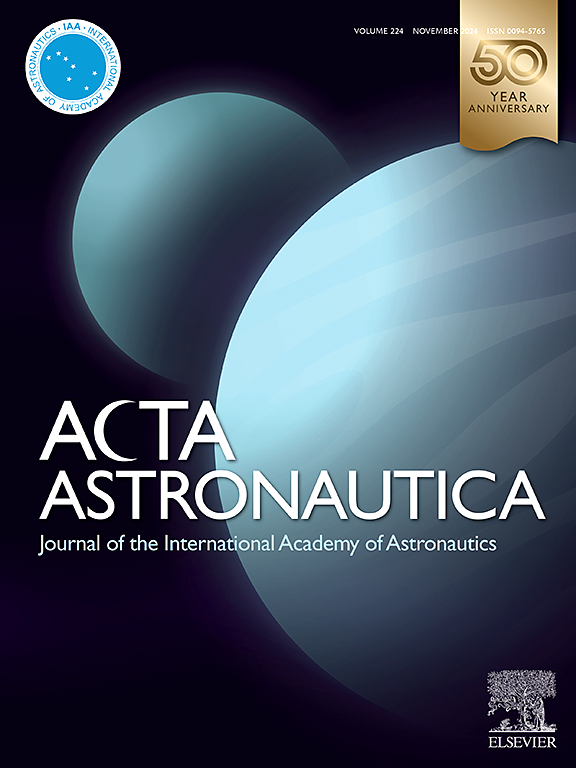Revealing the impact of operational constraints on aerodynamic collision avoidance maneuvers: In-flight results from the BEESAT-4 CubeSat
IF 3.1
2区 物理与天体物理
Q1 ENGINEERING, AEROSPACE
引用次数: 0
Abstract
Effective collision avoidance strategies will play a central role in the future in order to take account of the rapidly increasing number of satellites in Low Earth Orbit and the associated increase in collision probabilities. For small, lightweight satellites (e.g. CubeSats), propellantless options represent a highly attractive solution. A targeted change in the satellite’s ballistic coefficient alters the drag experienced and thus provides a way to actively adjust the satellite’s trajectory, e.g. to avoid an imminent collision. Despite extensive theoretical progress in this field, no in-orbit demonstrations of propellantless collision avoidance have been carried out to date. Thus, there exists a lack of experience on how potential operational limitations affect the theoretical considerations. To bridge the gap, a collaborative effort between the Julius-Maximilian Universität Würzburg, the Technische Universität Berlin, and the Universität Stuttgart has been initiated. This article presents the results of a joint study utilizing BEESAT-4, a conventional 1U CubeSat operated by the Technische Universität Berlin and launched into a 500 km Sun-synchronous orbit in June 2016. The study investigates how operational constraints impact the feasibility of maneuver sequences. To achieve this research objective, the impact of operational constraints on the effectiveness of orbital drag manipulation was evaluated. The analysis reveals that a consideration of the operational constraints reduces the maneuver effectiveness of an aerodynamically controlled collision avoidance maneuver for the BEESAT-4 satellite by almost 90 %. The reduction is revealed via theoretical considerations as well as an analysis of the in-orbit flight data conducted by OKAPI:Orbits GmbH. Overall, the findings are intended to enhance the practical deployment of sophisticated aerodynamic maneuvers in orbit, benefiting both the academic community and broader aerospace applications.
揭示操作约束对气动避碰机动的影响:来自BEESAT-4立方体卫星的飞行结果
考虑到近地轨道卫星数量的迅速增加以及由此带来的碰撞概率的增加,有效的避碰战略将在未来发挥核心作用。对于小型、轻型卫星(如立方体卫星),无推进剂方案是一种极具吸引力的解决方案。有针对性地改变卫星的弹道系数会改变所经历的阻力,从而提供了一种主动调整卫星轨迹的方法,例如避免即将发生的碰撞。尽管在这一领域取得了广泛的理论进展,但迄今为止还没有进行无推进剂避碰的在轨演示。因此,缺乏关于潜在的操作限制如何影响理论考虑的经验。为了弥合这一差距,朱利叶斯-马克西米利安Universität w rzburg, Universität柏林技术学院和Universität斯图加特之间的合作努力已经启动。本文介绍了利用BEESAT-4的联合研究结果,BEESAT-4是一颗由柏林技术公司Universität运营的常规1U立方体卫星,于2016年6月发射到500公里的太阳同步轨道。研究了作战约束对机动序列可行性的影响。为了实现这一研究目标,评估了操作约束对轨道阻力操纵有效性的影响。分析表明,考虑操作约束会使BEESAT-4卫星空气动力控制避碰机动的机动效率降低近90%。这种减少是通过理论考虑和OKAPI: orbital GmbH对在轨飞行数据的分析得出的。总的来说,这些发现旨在增强轨道上复杂气动机动的实际部署,使学术界和更广泛的航空航天应用受益。
本文章由计算机程序翻译,如有差异,请以英文原文为准。
求助全文
约1分钟内获得全文
求助全文
来源期刊

Acta Astronautica
工程技术-工程:宇航
CiteScore
7.20
自引率
22.90%
发文量
599
审稿时长
53 days
期刊介绍:
Acta Astronautica is sponsored by the International Academy of Astronautics. Content is based on original contributions in all fields of basic, engineering, life and social space sciences and of space technology related to:
The peaceful scientific exploration of space,
Its exploitation for human welfare and progress,
Conception, design, development and operation of space-borne and Earth-based systems,
In addition to regular issues, the journal publishes selected proceedings of the annual International Astronautical Congress (IAC), transactions of the IAA and special issues on topics of current interest, such as microgravity, space station technology, geostationary orbits, and space economics. Other subject areas include satellite technology, space transportation and communications, space energy, power and propulsion, astrodynamics, extraterrestrial intelligence and Earth observations.
 求助内容:
求助内容: 应助结果提醒方式:
应助结果提醒方式:


